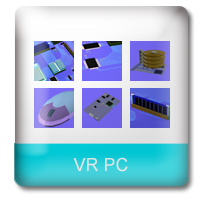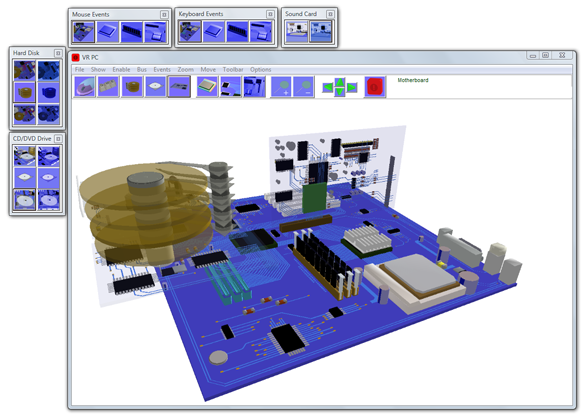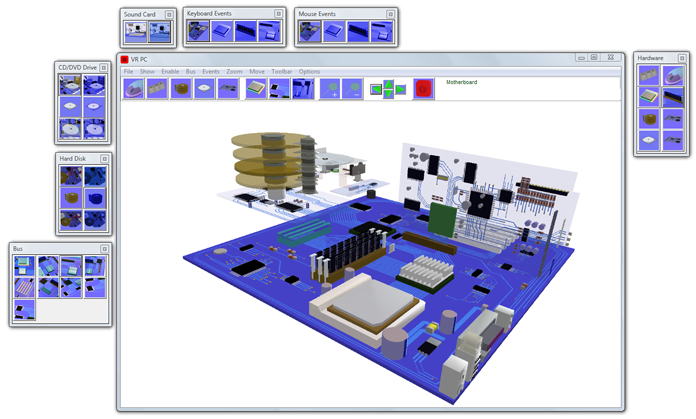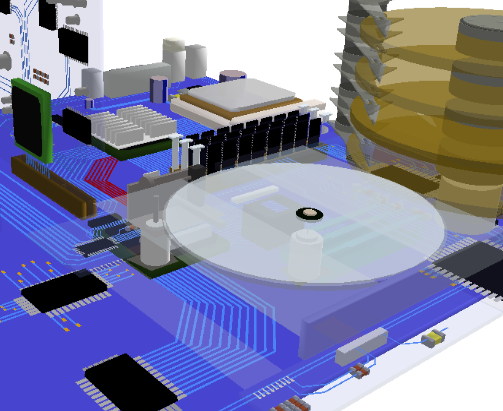VR PC
Simulates a pc

Camboard Technology
Computer science software for k12 and ks3 computing curriculum..
Key Features

Simulates a Motherboard..Hard Drive..
3D graphics Great for use with computer science and computing curriculum. VR PC is a virtual computer that simulates the main processes of a working PC. The virtual computer program is a great introduction to the inner workings of a computer. The 3D realistic parts of a virtual computers motherboard, sound card, AGP card, hard disk drive and cd/dvd drive are all simulated. Students can see what is going on inside a virtual computer. The computers main systems are simulated. The motherboard can be rotated and moved, you can zoom in onto the motherboard to see simulations close up. VR PC is a powerful simulation of the main processes involved in running applications and using hardware on a Windows Personal Computer.
The Mouse
When you click with computers mouse button Visual PC simulates what is going on inside your computer, with Visual PC you can see the path the data travels along on the virtual computers motherboard.
Keyboard
The virtual computers motherboard displays the data path a key press takes as it journeys to the computers CPU.
Motherboard
The Motherboard is based on a Intel Pentium processor. The board includes all the chips that would be found on a basic PC. Data flow is simulated between all the main chips. The main processes of the motherboard are simulated. These simulate data transfer between the CPU and Memory showing data flow between the North Bridge hub. The IDE interface is simulated to the CPU. CPU to AGP slot (Graphics card).
Mouse and Keyboard port simulated to CPU through LPC controller, South bridge and North bridge.
CPU
Visual PC monitors the computers processor as load changes are detected, the CPU to north bridge bus data lines turn red.

Simulates events...
VR PC simulates these events...
Mouse events
Simulates data travelling from the mouse port to the i/o controller then to south bridge. Data then travels to the north bridge and onto the CPU. From the CPU the mouse data is transferred back to the north bridge and into a memory location on the AGP card. When the data leaves the CPU it will update the graphics card with a new pointer position or menu opened etc.
Keyboard events
Simulates data travelling from the Keyboard port to the i/o controller then to south bridge. Data then travels to the north bridge and onto the CPU. From the CPU the Keyboard data is transferred back to the north bridge and into a memory location on the AGP card. When the data leaves the CPU it will update the graphics card with a new text cursor position etc.
Hard Disk events
(Read to Memory) simulates data being read from the hard drive to memory. The arms on the hard disk move across the platters to read data from a specific location. Data is then transferred to the hard disk controller which sits under the platters. A ribbon cable (not shown) connects the controller to the IDE slot on the motherboard. Data moves through the IDE slot to the south bridge. . Data then travels to the north bridge and onto the CPU. Data is transferred to memory from the CPU.
(Write from Memory) simulates data being written onto the hard drive from memory. Data is read from memory into the CPU. Data leaves the CPU and travels to the north bridge. From here the data travels to the south bridge. Data is then routed to the IDE connectors. Data is received onto the disk controller and then transferred to the write heads on the arms of the hard disk. The arms on the hard disk move across the platters to write data to a specific location

Simulates events...
CD/DVD Events
CD/DVD (Read to Memory) This simulates data being read from the CD. The laser is switched on to read data from a specific location. Data is then transferred to the CD controller which sits under the laser. A ribbon cable (not shown) connects the controller to the IDE slot on the motherboard. Data moves through the IDE slot to the south bridge. . Data then travels to the north bridge and onto the CPU. Data is transferred to memory from the CPU.
(Write from Memory) This simulates data being written onto the cd from memory. Data is read from memory into the CPU. Data leaves the CPU and travels to the north bridge. From here the data travels to the south bridge. Data is then routed to the IDE connectors. Data is received onto the disk controller and then converted into signals that fire a laser underneath the cd.
Sound Card Events
Sound Card (Microphone) Simulates analogue data from a microphone converted to digital data. Analogue data is inputted into the sound card through a socket. An analogue to digital converter (ADC) converts the signal into digital data. The sound card moves this data through the PCI connector onto the PCI bus. The data travels to the south bridge. Data then travels to the north bridge and onto the CPU. Sound Card (Loudspeakers) Simulates digital data being converted into an analogue signal which is fed to the speaker sockets on the sound card. Data leaves the CPU to the north bridge and travels to the south bridge. Data is routed to the PCI bus. The PCI socket connects the sound card to the PCI bus. Data is transferred from the PCI bus to the sound card.

System Requirements
Requires a PC or laptop
With Windows XP/VISTA/7/8/10 and DirectX 8.1 or higher.